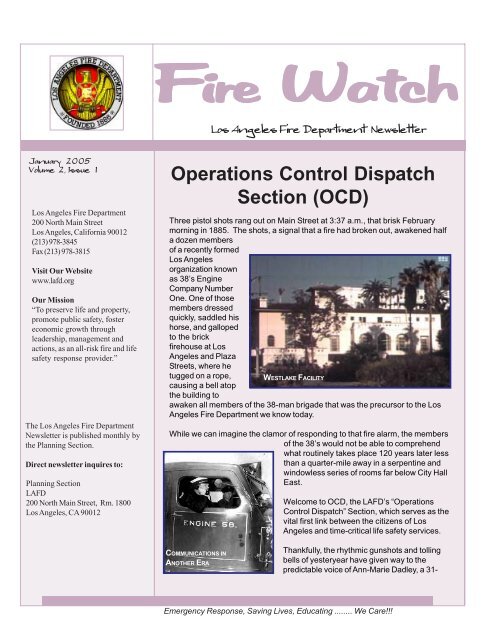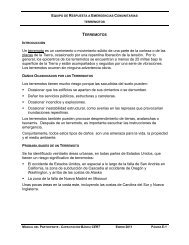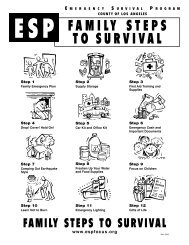Operation Control Dispatch Section - CERT Los Angeles
Operation Control Dispatch Section - CERT Los Angeles
Operation Control Dispatch Section - CERT Los Angeles
Create successful ePaper yourself
Turn your PDF publications into a flip-book with our unique Google optimized e-Paper software.
January 2005<br />
Volume 2, Issue 1<br />
<strong>Los</strong> <strong>Angeles</strong> Fire Department<br />
200 North Main Street<br />
<strong>Los</strong> <strong>Angeles</strong>, California 90012<br />
(213) 978-3845<br />
Fax (213) 978-3815<br />
Visit Our Website<br />
www.lafd.org<br />
Our Mission<br />
“To preserve life and property,<br />
promote public safety, foster<br />
economic growth through<br />
leadership, management and<br />
actions, as an all-risk fire and life<br />
safety response provider.”<br />
The <strong>Los</strong> <strong>Angeles</strong> Fire Department<br />
Newsletter is published monthly by<br />
the Planning <strong>Section</strong>.<br />
Direct newsletter inquires to:<br />
Planning <strong>Section</strong><br />
LAFD<br />
200 North Main Street, Rm. 1800<br />
<strong>Los</strong> <strong>Angeles</strong>, CA 90012<br />
Fire Fire Watch<br />
Watch<br />
<strong>Los</strong> <strong>Angeles</strong> Fire Department Newsletter<br />
<strong>Operation</strong>s <strong>Control</strong> <strong>Dispatch</strong><br />
<strong>Section</strong> (OCD)<br />
Three pistol shots rang out on Main Street at 3:37 a.m., that brisk February<br />
morning in 1885. The shots, a signal that a fire had broken out, awakened half<br />
a dozen members<br />
of a recently formed<br />
<strong>Los</strong> <strong>Angeles</strong><br />
organization known<br />
as 38’s Engine<br />
Company Number<br />
One. One of those<br />
members dressed<br />
quickly, saddled his<br />
horse, and galloped<br />
to the brick<br />
firehouse at <strong>Los</strong><br />
<strong>Angeles</strong> and Plaza<br />
Streets, where he<br />
tugged on a rope,<br />
causing a bell atop<br />
the building to<br />
awaken all members of the 38-man brigade that was the precursor to the <strong>Los</strong><br />
<strong>Angeles</strong> Fire Department we know today.<br />
While we can imagine the clamor of responding to that fire alarm, the members<br />
of the 38’s would not be able to comprehend<br />
what routinely takes place 120 years later less<br />
than a quarter-mile away in a serpentine and<br />
windowless series of rooms far below City Hall<br />
East.<br />
COMMUNICATIONS IN<br />
ANOTHER ERA<br />
WESTLAKE FACILITY<br />
Welcome to OCD, the LAFD’s “<strong>Operation</strong>s<br />
<strong>Control</strong> <strong>Dispatch</strong>” <strong>Section</strong>, which serves as the<br />
vital first link between the citizens of <strong>Los</strong><br />
<strong>Angeles</strong> and time-critical life safety services.<br />
Thankfully, the rhythmic gunshots and tolling<br />
bells of yesteryear have given way to the<br />
predictable voice of Ann-Marie Dadley, a 31-<br />
Emergency Response, Saving Lives, Educating ........ We Care!!!
year-old Linguistic Specialist from<br />
Colorado, who was chosen to<br />
serve as the automated dispatch<br />
voice of the LAFD. Ann-Marie will<br />
celebrate her virtual fifth<br />
anniversary with the LAFD in<br />
February, having worked 43,800<br />
OLD OCD<br />
continuous hours without a break.<br />
With the un-natural ability to<br />
communicate simultaneously with<br />
different messages to 32 different<br />
Fire Stations at any given moment,<br />
Ann-Marie (with more than a little<br />
help from Firefighter/<strong>Dispatch</strong>ers)<br />
alerted LAFD crews to 714,658<br />
responses last year alone, an<br />
average of 958 responses per day.<br />
While technology abounds at<br />
OCD, it takes highly trained<br />
personnel to use it. To begin the<br />
training, members must have a<br />
minimum of four years of field<br />
experience. Once selected for<br />
OCD training, members begin an<br />
arduous nine-week 40-hour-per<br />
week classroom training program.<br />
This training consists of learning<br />
the Department’s dispatch<br />
protocols, fire station locations,<br />
and specialty apparatus locations<br />
throughout the City. Following the<br />
classroom portion of the training,<br />
members are required to utilize<br />
their newly learned skills by<br />
working 20-24 hour shifts on the<br />
dispatch floor. Each of the newly<br />
<strong>Los</strong> <strong>Angeles</strong> Fire Department Newsletter<br />
trained dispatchers has an<br />
experienced dispatcher assigned<br />
to them as their trainer and mentor.<br />
Once the new dispatchers<br />
complete the more than 800 hours<br />
of training, they are ready to begin<br />
their new assignments as one of<br />
the 75<br />
LAFD<br />
<strong>Dispatch</strong>ers<br />
assigned to<br />
OCD. While<br />
headsetclad<br />
Firefighter/<br />
<strong>Dispatch</strong>ers<br />
are<br />
surrounded<br />
by high<br />
technology<br />
today, what<br />
got them<br />
there is an<br />
amazing<br />
story.<br />
LAFD’s<br />
RADIO<br />
SYSTEM<br />
In 1934, the<br />
<strong>Los</strong> <strong>Angeles</strong><br />
Fire<br />
Department<br />
installed <strong>Los</strong><br />
<strong>Angeles</strong> Police<br />
Department<br />
radio receivers<br />
and later<br />
transceivers<br />
exclusively in<br />
fire boats and<br />
Battalion<br />
Chiefs’ cars.<br />
While our Department continued to<br />
rely primarily on telephones and<br />
street-corner fire alarm boxes for<br />
field communications, the<br />
Westlake Signal Office on 6th<br />
Street near Alvarado, and the<br />
“Coldwater Signal Office” on<br />
Mulholland Drive, would often<br />
phone LAPD Communications<br />
when they had fires or other urgent<br />
messages for Battalion<br />
Commanders.<br />
WESTLAKE DISPATCHER AT WORK<br />
The actual fire calls were seldom<br />
broadcast over police radios as the<br />
Fire Department remained<br />
skeptical for years about the<br />
dependability of two-way radios.<br />
Instead, the Chiefs were simply<br />
told to “Phone Westlake (or<br />
Coldwater).” The Chiefs carried<br />
telephone handsets in their cars,<br />
and would stop at the nearest firealarm<br />
box, plug in, and receive<br />
their information from their<br />
respective Fire Department signal<br />
office.<br />
It wasn’t until 1946 that LAFD<br />
engines and trucks became<br />
equipped with two-way radios.<br />
Configured in the 33-MHz band,<br />
the frequencies from this original<br />
allocation were used into the late<br />
1980’s.<br />
Prior to modernization in 1972,<br />
LAFD dispatch operations were<br />
conducted manually in three<br />
separate locations throughout the<br />
City: Westlake, Coldwater and<br />
San Pedro Signal Offices. After a<br />
comprehensive study,<br />
consolidation of the three older<br />
dispatch sites into the new OCD in<br />
Level P-4 at City Hall East<br />
occurred. Implementation of the<br />
2
first generation computer-assisted<br />
“Fire Command and <strong>Control</strong> System”<br />
was not far behind.<br />
Today, every field member of the <strong>Los</strong><br />
<strong>Angeles</strong> Fire Department is<br />
equipped with a hand-held radio<br />
which provides them with a<br />
communication<br />
link to OCD as<br />
well as every<br />
LAFD resource<br />
in the City. This<br />
system operates<br />
on 18 dedicated<br />
voice radio<br />
channels<br />
utilizing the 800<br />
MHz band in a<br />
conventional<br />
analog format.<br />
We’ve come a<br />
long way!<br />
WORK LOAD<br />
In Fiscal Year 2002/03, a total of<br />
1,187,296 requests for service were<br />
received by OCD personnel. These<br />
calls for help resulted in over<br />
352,320 incidents being handled by<br />
the Department, or an average of<br />
965 per day. To really put things into<br />
perspective… That’s 20,830 calls<br />
taken by each Dipatcher per year at<br />
OCD.<br />
PERSONNEL<br />
There are 75 Firefighter III/<br />
<strong>Dispatch</strong>ers, 9 Captains, and 3<br />
Battalion Chiefs assigned on platoon<br />
duty at OCD. These personnel are<br />
equally divided into three platoons<br />
working the same 24-hour shifts as<br />
Neighborhood Firefighters. While onduty,<br />
the 25 <strong>Dispatch</strong>ers and 3<br />
Captains, all of whom have field<br />
experience and are certified as<br />
Emergency Medical <strong>Dispatch</strong>ers,<br />
are scheduled to work on the “floor”<br />
by alternating watches at various<br />
times during their 24-hour tour of<br />
duty. The number of <strong>Dispatch</strong>ers and<br />
<strong>Los</strong> <strong>Angeles</strong> Fire Department Newsletter<br />
FOUR FLOORS UNDER CITY HALL EAST<br />
Captains scheduled on the floor<br />
is normally 1 Captain and 11<br />
dispatchers. However, based on<br />
the Departments emergency<br />
needs, when necessary, all<br />
personnel can be summoned to<br />
the dispatch floor to augment the<br />
DISPATCH CONSOLE<br />
number of members on the<br />
dispatch floor.<br />
In addition to the members<br />
assigned to platoon duty at OCD,<br />
a small army of civilian and<br />
special-duty uniformed personnel<br />
work behind the scenes in the<br />
<strong>Dispatch</strong> System Support Unit to<br />
keep this vital operation up and<br />
running.<br />
QUALITY IMPROVEMENT<br />
All emergency and non-emergency<br />
communications at OCD are<br />
recorded 24 hours a day. The<br />
Department’s <strong>Dispatch</strong> Quality<br />
Improvement <strong>Section</strong> uses these<br />
recordings to provide training, and<br />
to routinely evaluate <strong>Dispatch</strong>er<br />
and system performance in an<br />
effort to continually improve the<br />
quality of service we deliver.<br />
EQUIPMENT<br />
Several sub-systems comprise the<br />
second generation Fire Command<br />
and <strong>Control</strong> System<br />
(FSCCS II) to provide each<br />
calltaker and <strong>Dispatch</strong>er with<br />
complete and current incident and<br />
resource status information. Each<br />
of the 22 dispatch consoles at<br />
OCD are fully equiped and capable<br />
of performing identical functions.<br />
Without leaving<br />
their seats, each<br />
<strong>Dispatch</strong>er and<br />
supervisor on<br />
duty has access<br />
to complete<br />
information and<br />
full control of all<br />
Department fire<br />
and EMS<br />
resources.<br />
DISPATCHING<br />
An available calltaker<br />
answers<br />
the emergency<br />
call and enters the incident type<br />
and location (if the call is a 9-1-1<br />
call, the location is automatically<br />
entered) into the computer. An<br />
identifying number is assigned<br />
automatically to the incident and<br />
the location is checked against the<br />
street index file by the computer.<br />
The computer determines the<br />
closest fire station, unit availability,<br />
and displays a recommended<br />
assignment of companies. The<br />
<strong>Dispatch</strong>er is also notified by the<br />
computer of any other incidents in<br />
3
progress within 1,500 feet of the new incident.<br />
<strong>Los</strong> <strong>Angeles</strong> Fire Department Newsletter<br />
EMS incidents require the call-taker to adhere to written protocols that include appropriate “key questions” and<br />
when indicated, pre-arrival instructions. “Key questions” are designed to ensure that the proper level of service<br />
is dispatched to every emergency medical incident while pre-arrival instructions help to provide comfort, and<br />
oftentimes life-saving instructions to citizen rescuers on scene prior to the arrival of Fire Department personnel.<br />
FUTURE OCD<br />
The Fire Department is in the final<br />
stages of finalizing plans for the future<br />
home for OCD. Built with Bond “Q”<br />
funds, the approxiatematly 80,000<br />
square-foot 2-story structure will be<br />
located at Temple and Alameda Streets<br />
adjacent to new Fire Station 4. The<br />
Department’s new Communication<br />
Appartus will also be housed at the<br />
new Station. The new dispatch center<br />
will house the Fire Department’s<br />
OCD,the the<br />
LAPD’s DOC, and the City of<br />
<strong>Los</strong> <strong>Angeles</strong>’ EOC, and will be<br />
equipped with state of the art<br />
technology. The new dispatch center<br />
will have the capability to house up to<br />
42 Fire Department members.<br />
CONCLUSION<br />
OFFICE OF THE PUBLIC SERVICE OFFICER(PSO)<br />
OUR LIAISON WITH THE MEDIA<br />
The <strong>Los</strong> <strong>Angeles</strong> Fire Department is the only major metropolitan fire department in the United States that<br />
provides its citizenry with the benefit of highly trained dispatch personnel with years of field fire and EMS<br />
experience.<br />
Without fail and 24 hours a day, 7 days a week, 365 days a year, the men and women at OCD continue to<br />
provide the vital communication lifeline between the <strong>Los</strong> <strong>Angeles</strong> Fire Department and the citizens we serve.<br />
Special thanks to Public Service Officer Brian Humphrey for providing valuable input into<br />
this month’s Fire Watch. Brian Humphrey is a Paramedic trained Firefighter and 20-year<br />
veteran of the <strong>Los</strong> <strong>Angeles</strong> Fire Department. He has served as the “B” Platoon Public<br />
Service Officer since 1993. A fifth generation Californian, Brian has harbored a fascination<br />
with America’s Fire Service in general, and the LAFD in particular since his Fire Service<br />
Day visit to Fire Station 39 in 1966.<br />
4




